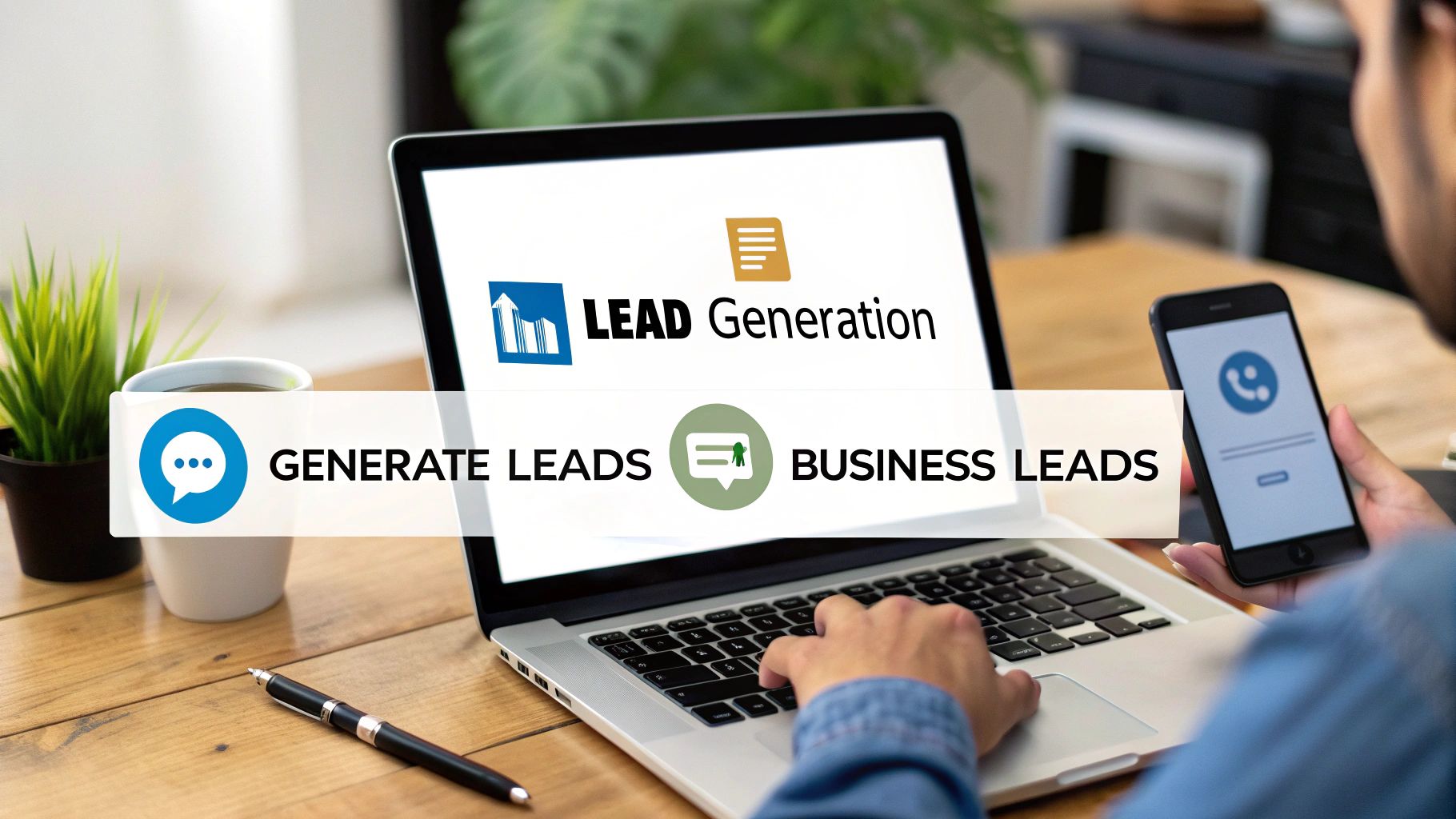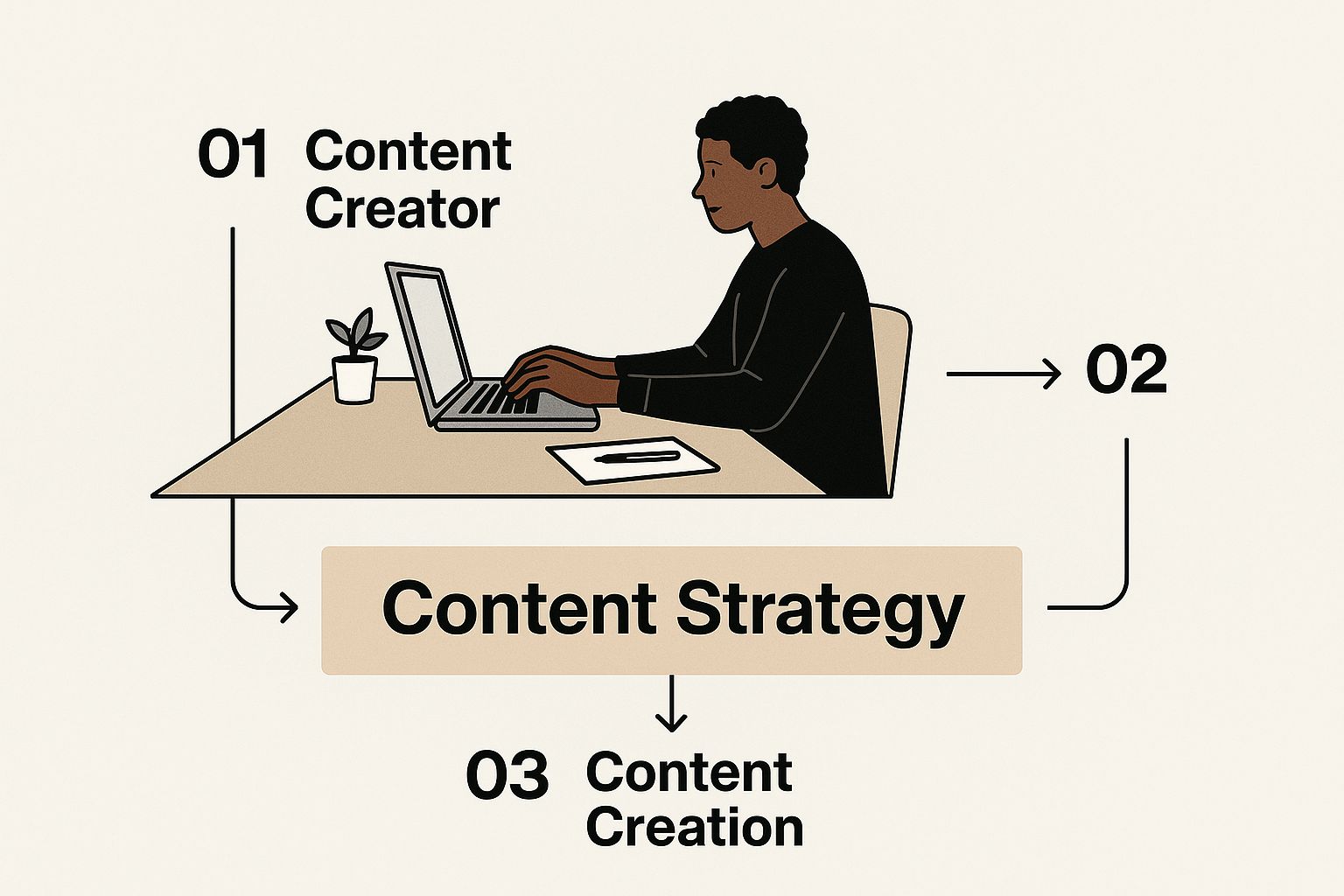
How to Generate Business Leads: Proven Strategies & Tips
Published on 2025-09-14
If you want to generate business leads consistently, you need a system. It’s really that simple. A predictable system requires three things: knowing exactly who your ideal customer is, showing up where they hang out online with genuinely useful content, and using the right channels—like LinkedIn and SEO—to make it all happen. This isn't about random acts of outreach; it's a focused strategy that pulls in people who are actually interested in what you have to offer.

Shifting From Outdated Tactics to a Modern Strategy
Let’s be honest. The old playbook is broken. Casting a wide net with generic cold calls and mass email blasts just doesn’t cut it anymore. Today, effective lead generation is all about precision, value, and building a relationship before you ever ask for the sale. We've moved away from interrupting people to attracting them.
This isn't just some marketing trend; it’s a direct response to how people buy things now. Your potential customers are smarter and more resourceful than ever. They don't want a sales pitch; they want help solving their problems. That means your entire approach has to be built around providing real solutions and expertise, positioning your brand as the go-to resource long before a transaction is even on the table.
The New Priorities in Lead Generation
No surprise, lead generation is still a huge deal for businesses—in fact, 50% of marketers say it's their main focus. What has changed are the methods.
Think about it: 97% of people now completely ignore traditional cold calls. So where has the attention gone? The data points to a clear shift. Today, 76% of marketers lean on content marketing, and 68% use social media to bring in better, more qualified leads.
This paints a pretty clear picture. Your energy is best spent creating and sharing valuable content that naturally pulls prospects toward you. Having a solid online presence isn't just a nice-to-have anymore; it's the engine of any modern lead generation machine. If you're just getting started, our guide on https://autoghostwriter.com/blog/how-to-build-online-presence is a great place to begin.
The heart of modern lead generation isn't about finding customers. It's about making it easy for the right customers to find you. You do this by consistently showing up with value and expertise right where your audience is already looking for answers.
Building Your Foundational Channels
To build a healthy sales pipeline, you need to understand the different ways to get in front of people. I like to think of a strong strategy as having two parts that work in tandem:
- Inbound Methods: This is your magnet. Think SEO and content marketing, where you create genuinely helpful resources that attract people who are actively searching for solutions.
- Outbound Methods: This is your targeted outreach, but with a modern touch. We're talking personalized, thoughtful engagement on platforms like LinkedIn, not old-school spam.
When you blend these two approaches, you create a much more resilient system. For a deeper look at these tactics, this guide on 10 B2B lead generation strategies for success is fantastic. The real magic happens when your inbound efforts warm up your audience, making your outbound messages feel less like an interruption and more like a welcome conversation.
Choosing the right channels is half the battle. This table breaks down some of the most effective options available today so you can see where your efforts might have the biggest impact.
Key Lead Generation Channels at a Glance
| Channel | Best For | Key Metric |
|---|---|---|
| B2B networking, professional services, high-ticket sales | Engagement Rate, Connection Requests Accepted | |
| SEO | Long-term, sustainable traffic for specific problems | Organic Traffic, Keyword Rankings, Conversions |
| Content Marketing | Building authority, educating the market, nurturing leads | Downloads, Email Sign-ups, Time on Page |
| Email Marketing | Nurturing existing leads, direct communication | Open Rate, Click-Through Rate, Reply Rate |
| PPC Ads | Quick, targeted traffic for specific offers | Cost Per Lead (CPL), Click-Through Rate (CTR) |
Ultimately, the best strategy is rarely about picking just one channel. It’s about creating a complementary mix that meets your audience where they are and guides them toward a solution—yours.
So, Who Are You Actually Selling To?
Before you even think about generating a single lead, you need to know exactly who you're trying to reach. So many businesses fall into the trap of casting a wide net, hoping to catch anyone and everyone. That's a surefire way to waste time and money. The real goal is to build a detailed Ideal Customer Profile (ICP)—a living, breathing document that becomes the true north for everything you do in sales and marketing.
A solid ICP goes way beyond basic demographics like age, location, or job title. It gets into the messy, human side of your best customers. What are their biggest professional headaches? What really keeps them up at night? What does a huge "win" look like for them in their role? When you can answer these questions, you stop chasing a vague target and start talking to a specific person.
Ditch the Generic Personas
Forget those cookie-cutter templates you can download online. A truly effective ICP isn't built in a vacuum during a brainstorming session; it’s built from real data and honest conversations. The best insights always come straight from the source.
The first place to look is your existing customer list. Who are your absolute best clients? The ones who are happy, profitable, and you just wish you could clone. Pick out the top 5-10 accounts that fit this description. They are the foundation of your ICP.
Once you have that shortlist, it's time to do some digging.
- Dive into your sales data: Look for common threads. What industries, company sizes, or tech stacks keep popping up among your best clients? Patterns will start to emerge.
- Talk to your customers: This is non-negotiable. Get on a quick call and ask them about the challenges they had before they found you and the results they've seen since.
- Chat with your sales team: These folks are on the front lines every day. They know the common objections, the real buying triggers, and the questions that prospects always ask.
Your Ideal Customer Profile isn't just a theoretical exercise. It's a practical tool forged from real-world data and conversations. It gives you the focus to stop shouting at everyone and start having meaningful conversations with the right people.
Finding the Insights That Matter
As you're gathering all this info, your main goal is to uncover the "why" behind their decisions. You want to move past simple company details and get a deep, almost psychological understanding of your ideal buyer. It's not just about who they are, but how they think and what truly motivates them.
For example, don't just write down that they're in the "SaaS industry." Find out what specific problems SaaS companies of that size are grappling with. Is it user churn? The nightmare of scaling their infrastructure? The struggle to break into a new market?
This is the level of detail that lets you craft messaging that actually hits home. When a prospect reads your LinkedIn post and has that "Wow, they really get me" moment, you know your ICP is working. That connection is the first, and most important, step in turning a complete stranger into a fantastic business lead.
Turn LinkedIn Into Your Lead Generation Engine
Let’s be honest: for most people, LinkedIn is just a digital resume collecting dust. But for savvy B2B pros, it’s the single most powerful tool for generating a steady stream of high-quality business leads. The trick is to stop using it passively. Don't just sit there waiting for opportunities to find you—you have to actively build a system that brings them to your door.
This requires a total mindset shift. Stop thinking about LinkedIn as a place to send cold pitches. Instead, see it as your digital town square, a place to build real relationships and become a trusted authority. The goal is to be the first person your ideal clients think of when they have a problem you can solve.
Optimize Your Profile for Discovery
Before you even think about reaching out to anyone, your profile needs a serious tune-up. It's your digital storefront, and right now, it might be telling the wrong story. You need to optimize it specifically for your Ideal Customer Profile (ICP).
A few simple changes can make all the difference.
- Your Headline: Ditch the boring job title. Seriously. Instead of "Sales Manager at XYZ Corp," try something that screams value, like "I Help SaaS Founders Slash Churn with Smarter Onboarding." See the difference? One is about you; the other is about them.
- Your About Section: This is your spot to tell a story, not just list accomplishments. Talk about the real-world problems you solve and who you solve them for. Weave in keywords your prospects are actually searching for so they can find you.
- Your Featured Section: This is prime real estate! Pin your best stuff here—a killer case study, a link to your most helpful blog post, or a video that shows off your expertise.
A well-optimized LinkedIn profile does more than just list your experience. It acts as a 24/7 magnet, drawing in qualified prospects and pre-selling them on your value before you ever have a conversation.
Connect with Purpose and Personalization
Forget about those generic, automated connection requests. They’re spammy, they rarely work, and they can kill your credibility before you even start. The real secret to effective outreach on LinkedIn is combining genuine personalization with smart, scalable systems. You’re trying to start a real conversation, not just boost your connection count.
This infographic breaks down a simple, content-first approach that actually works.

As you can see, a solid content strategy is the foundation. It gives you a reason to connect and a way to provide value right from the start.
Instead of the lazy "I'd like to connect," try referencing something specific. Did they share a great post? Comment in a group you’re both in? Mention a mutual connection. For example: "Hi Jane, I saw your post on the challenges of remote team management and loved your point about asynchronous communication. I'd love to connect and follow your insights."
This small bit of effort shows you've done your homework and are genuinely interested in what they have to say. It’s a game-changer.
Share Content That Establishes Authority
Consistently posting valuable content is the fastest path to building trust and authority on LinkedIn. This isn't about bragging or non-stop self-promotion. It's about educating your audience. Share your unique insights, comment on industry trends, and answer the common questions your ICP is always asking.
Think about it: with over one billion users, LinkedIn is a massive stage. A recent study found that 53% of B2B marketers are already actively using it to find prospects and source information. Sharing great content is how you cut through the noise and get noticed by the right people.
When you become a go-to resource, you naturally build an audience of potential leads who already see you as an expert. If you need a roadmap, check out our guide on how to become a genuine thought leader by leaning into your unique expertise. This whole approach warms up your outreach, brings in more qualified inbound leads, and turns LinkedIn into a reliable engine for your sales pipeline.
Attract Inbound Leads with Content and SEO
Instead of always chasing down new business, what if you could build a system where ideal clients come straight to you? That’s exactly what an inbound strategy does, using great content and smart search engine optimization (SEO) to draw people in. It's a fundamental shift from interrupting prospects to attracting them because you have the answers they're already looking for.
Think about your ideal customer for a second. They're not just sitting around waiting for a cold call. They're on Google, typing in their biggest frustrations and most pressing questions. Your job is to be the top result when they hit "search," offering a blog post, a guide, or a case study that genuinely helps them solve that problem. When you do that, you're not just another vendor—you're a trusted expert.
Create Content That Solves Real Problems
The entire inbound approach is built on content that actually serves your audience. This means no more thinly veiled sales pitches or generic company news. You need to create content that speaks directly to the specific pain points and challenges of your ideal customers.
To pull this off, you have to put on your problem-solver hat.
- Pinpoint Their Core Questions: What are the top 5-10 questions you hear on every single sales call? Boom. Each one of those is a potential blog post.
- Lean into 'How-To' Guides: People love practical, step-by-step instructions. Create guides that walk them through a process you’ve mastered.
- Prove It with Case Studies: Nothing builds credibility faster than showing the real-world results you've gotten for clients just like them.
It's no surprise that websites with a blog generate, on average, 67% more leads than those that don't. It's not a fluke. It's a direct result of consistently providing value and creating more pathways for prospects to find you. Every helpful article you publish is another open door to your business.
The secret to generating leads with content is to stop selling and start helping. When you share your expertise generously, you build the kind of trust and authority that naturally brings your ideal customers to you.
Make Sure Your Content Gets Found
Of course, writing brilliant content is only half the job. If nobody sees it, it won't generate a single lead. This is where SEO becomes your best friend, making sure all that hard work actually shows up in front of the people who need to see it.
The competition for attention online is intense, and organic search is a major playing field. The North American lead generation market is expected to hit a staggering $3.62 billion USD by 2028, and even with all the new channels out there, 27% of marketers say organic search is still their number one lead source. That tells you just how valuable a top spot on Google really is.
Getting your content optimized doesn't have to be some dark art. Just start with the fundamentals. For each article, figure out the main keyword or phrase your ideal customer would type into Google. Then, weave it naturally into your title, your subheadings, and throughout the text.
To really get ahead of the competition and build a consistent flow of inbound leads, it pays to go deeper. A solid foundation is key, and these 10 Search Engine Optimization Strategies are a great place to start. A strategic approach like this ensures your content connects with the right audience, turning your website into a lead-generating machine that works for you 24/7.
Scale Your Outreach with AI and Automation
So, you've got a system that’s working. That's fantastic. But now you're facing a new problem: how do you scale it without burning yourself out or letting the quality of your outreach nosedive? Manual outreach is powerful, but let's be honest, it has a ceiling. This is the perfect moment to bring in AI and automation—not to replace you, but to amplify your efforts.
Think of technology as your new assistant. It’s not here to take over the real conversations, but to free you up to have more of them. The right tools can handle all the tedious, repetitive stuff that eats up your day—like drafting those first-touch messages or remembering to follow up. This lets you pour your energy into what really matters: nurturing warm leads who are actually interested in what you have to say.

Craft Personalized Messages at Scale
One of the biggest game-changers I've seen in lead generation is how AI can now write incredibly personalized messages. We can finally ditch those stale, generic templates that everyone sees coming from a mile away and immediately ignores.
Modern AI tools can scan a prospect's LinkedIn profile, check out their recent posts, and pull in company details to whip up a unique opening line or even a full message that feels like you wrote it just for them. It’s the perfect blend of automated speed and human nuance.
For instance, an AI tool could spot that your prospect just posted about new industry trends and draft a message that references it. Or it might notice a shared connection and use that as a warm, non-spammy way to break the ice. If you want to dive deeper, you can explore various AI content creation tools built specifically for this, ensuring every interaction feels high-quality.
Automation should handle the tasks, not the relationships. Use it to manage the process so you have more time to build genuine connections with your most promising leads.
Automate Your Follow-Up Sequences
Here’s a statistic that always gets me: 80% of sales require five follow-up touches. Yet most of us give up after just one or two tries. That gap is where a staggering number of opportunities just vanish into thin air. Automating your follow-ups is the safety net that makes sure no lead ever slips through the cracks simply because you got busy.
You can create simple, automated workflows that send a series of personalized messages over a few days or weeks. It’s not about spamming them; it’s about staying gently persistent.
Here’s what a simple sequence could look like:
- Day 1: Send the initial personalized connection request on LinkedIn.
- Day 3: Follow up with a message sharing a valuable piece of content, like a relevant blog post or case study.
- Day 7: Send a quick check-in to see if they had any thoughts on the resource.
- Day 14: Offer a final, low-pressure message asking if the timing isn't right and suggesting you connect down the road.
This kind of structured approach keeps you on their radar without being annoying. For anyone trying to grow a team, learning how to automate lead generation is a must for maximizing efficiency. By building a reliable system, you can stop chasing cold leads and start focusing your energy on the prospects who are actually engaging. It makes your entire process far more effective and, more importantly, scalable.
Got Questions About Generating Leads? We’ve Got Answers.
Even with the best plan in hand, you're bound to have questions as you dive into generating business leads. It's totally normal. Getting the fundamentals straight is what keeps you from chasing shiny objects and helps you focus on what actually moves the needle.
Let's clear up a few of the most common questions I hear from people building out their lead gen machine.
What’s the Best B2B Lead Generation Strategy?
Everyone wants to know the "one secret" or the single best strategy. The truth? It doesn't exist. The right approach for a global SaaS company is going to look completely different from what works for a boutique marketing agency. It all comes down to your specific industry and, most importantly, your Ideal Customer Profile (ICP).
That said, a multi-pronged approach is almost always the winner. When you combine highly personalized outreach on platforms like LinkedIn with genuinely helpful content and a solid SEO foundation, you create a powerful, resilient system.
The real key is to focus on building relationships first. Give value, share your expertise, and establish trust before you even think about asking for a sale. When you do that, the sales conversation feels like a natural next step, not a pushy pitch.
How Do I Know if What I'm Doing is Actually Working?
It's easy to get fixated on the total number of leads coming in, but that number can be a vanity metric. If you generate 100 new leads but none of them are a good fit, you’ve just created a lot of busywork for your sales team.
To really understand your return on investment (ROI), you need to look a little deeper. Focus on tracking the metrics that tell the whole story:
- Lead Quality: How closely does a new lead match your ICP? A simple scoring system can work wonders here.
- Conversion Rate: What percentage of those qualified leads actually turn into paying customers?
- Cost Per Acquisition (CPA): This is the bottom line—how much are you spending to land one new customer?
- Sales Cycle Length: How long does it take for a person to go from "just browsing" to a closed deal?
Tracking these KPIs gives you a true health report for your sales pipeline. It helps you shift from a mindset of "get more leads" to "get the right leads," which is where the real profit is.
Seriously, How Long Will This Take?
This is the big one, and it requires a bit of patience. The timeline really depends on your strategy. If you're going the outbound route—think direct messaging on LinkedIn or targeted cold emails—you can start seeing conversations spark within a few weeks. The feedback loop is fast, but it can be a grind to scale.
Inbound, on the other hand, is a slow burn. Things like SEO and content marketing are a long-term play. You're likely looking at 3-6 months before you start seeing a consistent, reliable flow of leads from your efforts. But the reward for that patience is a sustainable, scalable lead engine that brings qualified prospects to your door 24/7.
Ready to stop guessing and start creating LinkedIn content that actually attracts your ideal clients? autoghostwriter gives you the AI-powered tools to produce authentic, engaging posts that build your authority and drive real business. Start your journey at https://autoghostwriter.com.